Multi-Objective Optimization of Surface Integrity in the Grind-Hardening Process
Abstract
1. Research Background
2. Current Status of Research on Surface Integrity in Grinding Operations
3. Design of the Grind-Hardening Process
3.1. Test Platform Construction
3.2. Test Material
3.3. Experimental Design of the Response Surface
3.4. Test Results
4. Influence of Grinding Parameters on the Integrity of Grind-Hardened Surfaces
4.1. Influence of Grinding Parameter on Surface Roughness of Grind-Hardened Surfaces
4.2. Influence of Grinding Parameter on the Depth of Hardened Layer
4.3. Influence of Grinding Parameters on Burr Change in the Grind-Hardening Process
5. Multi-Response Optimization Analysis of Grinding Parameters Multi-Objective Response Optimization
5.1. Multi-Objective Response Optimization
5.2. Analysis of Optimization Results
5.3. Validation of the Optimization Model
6. Conclusions
Author Contributions
Funding
Institutional Review Board Statement
Informed Consent Statement
Data Availability Statement
Conflicts of Interest
References
- Brinksmeier, E.; Brockhoff, T. Randschicht-Wärmebehandlung dursh Schleifen. Häerterei—Tech. Mitteilungen 1994, 49, 327–330. [Google Scholar]
- Brockhoff, T. Grinding-hardening: A comprehensive view. Ann. CIRP 1999, 48, 255–260. [Google Scholar] [CrossRef]
- Wang, G.C.; Liu, J.D.; Pei, H.J.; Jia, Z.H.; Ma, L.J. Study on Forming Mechanism of Surface Hardening in Two-Pass Grinding 40Cr Steel. Key Eng. Mater. 2006, 304–305, 588–592. [Google Scholar] [CrossRef]
- Liu, J.D.; Wang, G.C.; Wang, Z.; Fan, S.T. Experimental research of grind-hardening of 65Mn steel. Mater. Sci. Forum 2006, 505–507, 787–792. [Google Scholar] [CrossRef]
- Liu, J.D.; Wang, G.C.; Wang, B.; Chen, K.M. Study on the Formation of Grind-Hardening of Steel AISI 1066. Key Eng. Mater. 2007, 329, 57–62. [Google Scholar] [CrossRef]
- Nguyen, T.; Zhang, L.C.; Sun, D.L. Heat transfer in grinding-hardening of a cylindrical component. Adv. Mater. Res. 2011, 325, 35. [Google Scholar] [CrossRef]
- Nguyen, T.; Zhang, L.C. Realisation of grinding-hardening in workpieces of curved surfaces—Part 1: Plunge cylindrical grinding. Int. J. Mach. Tools Manuf. 2011, 51, 309–319. [Google Scholar] [CrossRef]
- Nguyen, T.; Liu, M.; Zhang, L.C.; Wu, Q.; Sun, D. An investigation of the grinding-hardening induced by traverse cylindrical grinding. J. Manuf. Sci. Eng. Trans. ASME 2014, 136, 051008. [Google Scholar] [CrossRef]
- Liu, W.; Yuan, H.C.; Shi, X.Y.; Liu, T.; Du, S.S. Experimental study on residual stress in high-speed grinding of noncircular equidistant profle. Int. J. Adv. Manuf. Technol. 2022, 123, 3399–3406. [Google Scholar] [CrossRef]
- Khodaii, J.; Adibi, H.; Barazandeh, F.; Rezaei, M.; Sarhan, A.A. Investigation of the surface integrity, flexural strength on the grinding of alumina for biomedical applications. Precis. Eng. 2021, 67, 110–122. [Google Scholar] [CrossRef]
- Xiao, G.J.; Chen, B.Q.; Li, S.C.; Zhuo, X.Q.; Zhao, Z.Y. Surface integrity and fatigue performance of GH4169 superalloy using abrasive belt grinding. Eng. Fail. Anal. 2022, 142, 106764. [Google Scholar] [CrossRef]
- Zhao, L.S.; Zhang, J.J.; Du, J.; Li, B.X.; Zhang, J.M.; Su, Z.S. Investigation on Surface Integrity of Nodular Cast Iron QT700-2 in Shape Adaptive Grinding. Micromachines 2023, 14, 276. [Google Scholar] [CrossRef] [PubMed]
- Zou, J.F.; Pei, H.J.; Hua, C.L.; Jiao, B.; Wang, G.C. Residual stress distribution at grind-hardening layer surface of the 40Cr workpiece. Mater. Res. Innov. 2015, 19, 580–584. [Google Scholar] [CrossRef]
- Jiao, B. Surface Integrity and Experimental Research on Grind-Hardening Process of 42CrMo Steel. Master’s Thesis, Jiangsu University, Zhenjiang, China, 2016. [Google Scholar]
- Guo, Y.; Xiu, S.C.; Liu, M.H.; Shi, X.L. Uniformity mechanism investigation of hardness penetration depth during grind-hardening process. Int. J. Adv. Manuf. Technol. 2017, 89, 2001–2010. [Google Scholar] [CrossRef]
- Wang, C.Y.; Wang, G.C.; Shen, C.G. Analysis and prediction of grind-hardening surface roughness based on response surface methodology-BP neural network. Appl. Sci. 2022, 12, 12680. [Google Scholar] [CrossRef]
- Hong, Y.; Sun, C.; Xiu, S.C.; Deng, Y.S.; Yao, Y.L.; Kong, X.N. Phase evolution and strengthening mechanism induced by grinding hardening. Int. J. Adv. Manuf. Technol. 2022, 120, 5605–5622. [Google Scholar] [CrossRef]
- Zhao, X.F.; Liu, J.D.; Huang, S.W. Effect of grinding parameter on grinding-hardened case and its uniformity of nodular cast iron QT400. Heat Treat. Met. 2022, 47, 198–203. [Google Scholar]
- Zhao, B.Q. Heat Treatment Manual for Tool Steels; China Machine Press: Beijing, China, 2014. [Google Scholar]
- Cui, Z.Q.; Qin, Y.C. Metallogy and Heat Treatment; China Machine Press: Beijing, China, 2020. [Google Scholar]
- GB/T 33362-2016; Conversion of Hardness Values of Metal Materials. Standardization Administration of China: Beijing, China, 2016.
- Zhang, J. Experimental Study and Analysis of Single Plane Grind-hardening Process. Master’s Thesis, Jiangsu University, Zhenjiang, China, 2018. [Google Scholar]
- Box, G.E.P.; Wilson, K.B. On the experimental attainment of optimum conditions. J. R. Stat. Soc. 1951, 13, 1–45. [Google Scholar] [CrossRef]
- Khuri, A. Multiresponse surface methodology. In Handbook of Statistics: Design and Analysis of Experiments; Ghosh, A., Rao, C.R., Eds.; Elsevier: Amsterdam, The Netherlands, 1996; Volume 13, pp. 377–406. [Google Scholar]
- Derringer, G.; Suich, R. Simultaneous optimization of several response variables. J. Qual. Technol. 1980, 12, 214–219. [Google Scholar] [CrossRef]
- Wang, J.J.; Ma, Y.Z.; Ouyang, L.H.; Tu, Y.L. Bayesian modeling and optimization for multi-response surfaces. Comput. Ind. Eng. 2020, 142, 106357. [Google Scholar] [CrossRef]
- Jeong, I.J.; Kim, K.J. An interactive desirability function method to multiresponse optimization. Eur. J. Oper. Res. 2009, 195, 412–426. [Google Scholar] [CrossRef]
- Zhang, Y.B.; Zhang, W.C.; Li, Y.S.; Zhao, L.M.; Li, H.Y.; Lei, Y.B.; Yang, Y.Q. Experimental of Consolidation Performance of Laterite in Plateau Based on RSM. Mater. Rep. 2023, 37, 259–264. [Google Scholar]
- Wu, H.; Lin, S.Y.; Li, X.K.; Gong, Y.H.; Wei, D.Q. Effect of induction hardening on microstructure and properties of 42CrMo steel crankshaft connecting rod journal. Jinshu Rechuli/Heat Treat. Met. 2022, 47, 119. [Google Scholar]
- Wei, S.T.; Wu, C.J.; Zheng, L.G.; Hu, X.Q.; Lu, S.P. Effect of surface quenching process on hardened layer of 42CrMosteel for large bearing ring. Heat Treat. Met. 2022, 47, 218–223. [Google Scholar]
- Liu, J.C. Study on Surface Integrity and Corrosion Resistance of42CrMoSteel after Ultrasonic Surface Rolling Process. Master’s Thesis, Dalian Maritime University, Dalian, China, 2022. [Google Scholar]
- Zhao, Y.H.; Wang, K.; Wang, Z.L.; Shi, M.J.; Li, F.F.; Ye, C.C. Effect of different surface treatments of 42CrMo steel piston rod on its corrosion resistance in sodium chloride solution. Int. J. Electrochem. Sci. 2022, 17, 1452–3981. [Google Scholar] [CrossRef]
- Zhang, Q.L.; Huang, H.; Tang, Z.H.; Li, G.C.; Niu, Q.A.; Chen, Z.J.; Du, Y.Q.; Yao, J.H. Rolling Wear and Fatigue Damage Behavior of Laser-Induction Hybrid Quenching on 42CrMo Steel. Chin. J. Lasers 2022, 49, 250–261. [Google Scholar]
- Zhang, Q.L.; Tong, W.H.; Chen, Z.J.; Yao, J.H.; Li, Z.G.; Feng, K.; Kovalenko, V.S. Effect of Spot Size on Geometrical Characteristics of Laser Deep Quenching Hardened Layer of 42CrMo Steel. Surf. Technol. 2020, 49, 254–261. [Google Scholar]
- Jiao, L.; Shang, H.K.; He, J.F.; Zhao, Y.J.; Zhang, W.M.; Li, W.M.; Zhou, L.M. Fracture failure analysis of 42CrMo steel high strength bolts for diesel engine. Heat Treat. Met. 2021, 46, 245–249. [Google Scholar]
- Chen, J.D.; Mo, W.L.; Wang, P.; Lu, S.P. Effects of tempering temperature on the impact toughness of steel 42crmo. Acta Metall. Sin. 2012, 48, 1186–1193. [Google Scholar] [CrossRef]
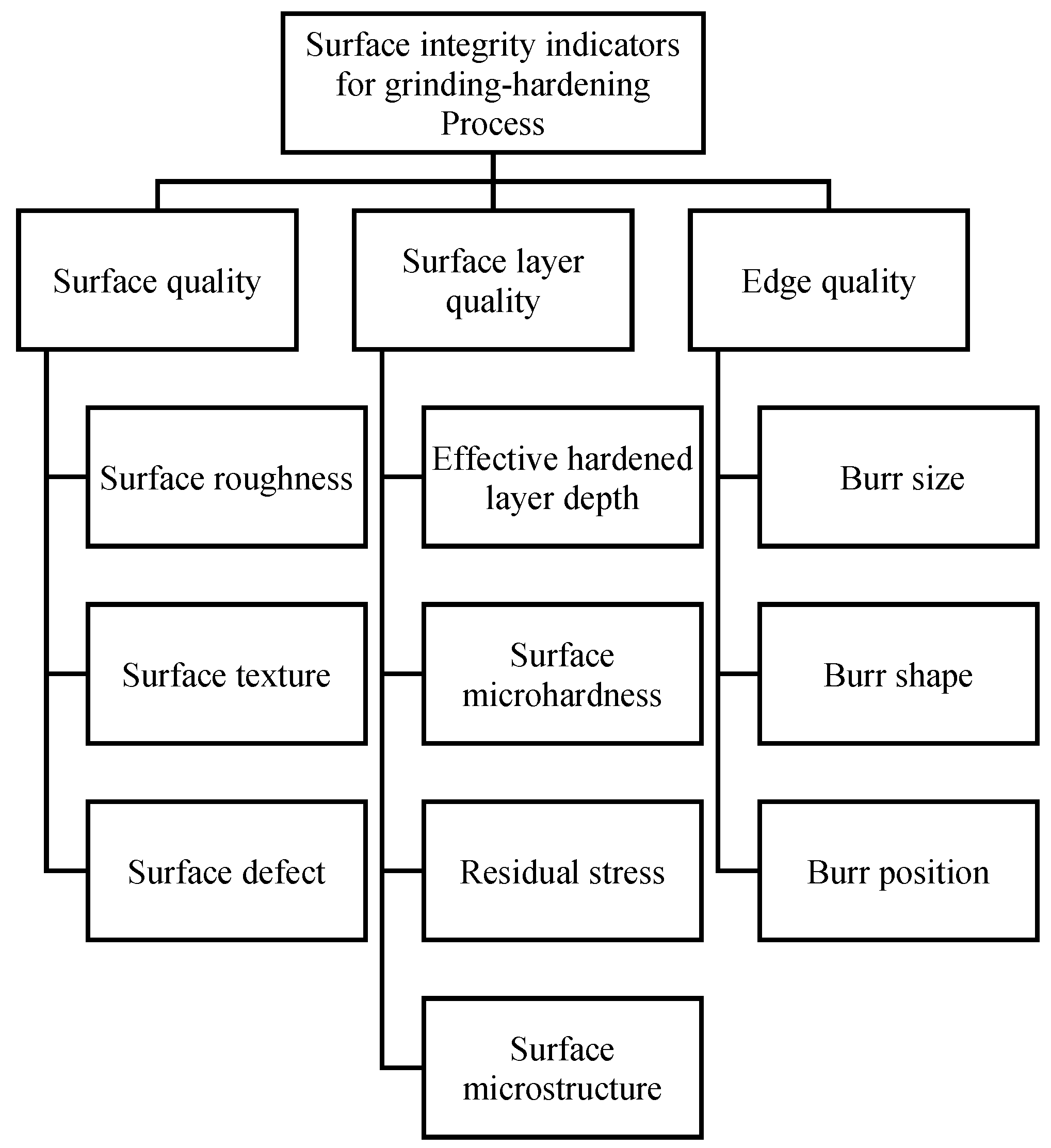



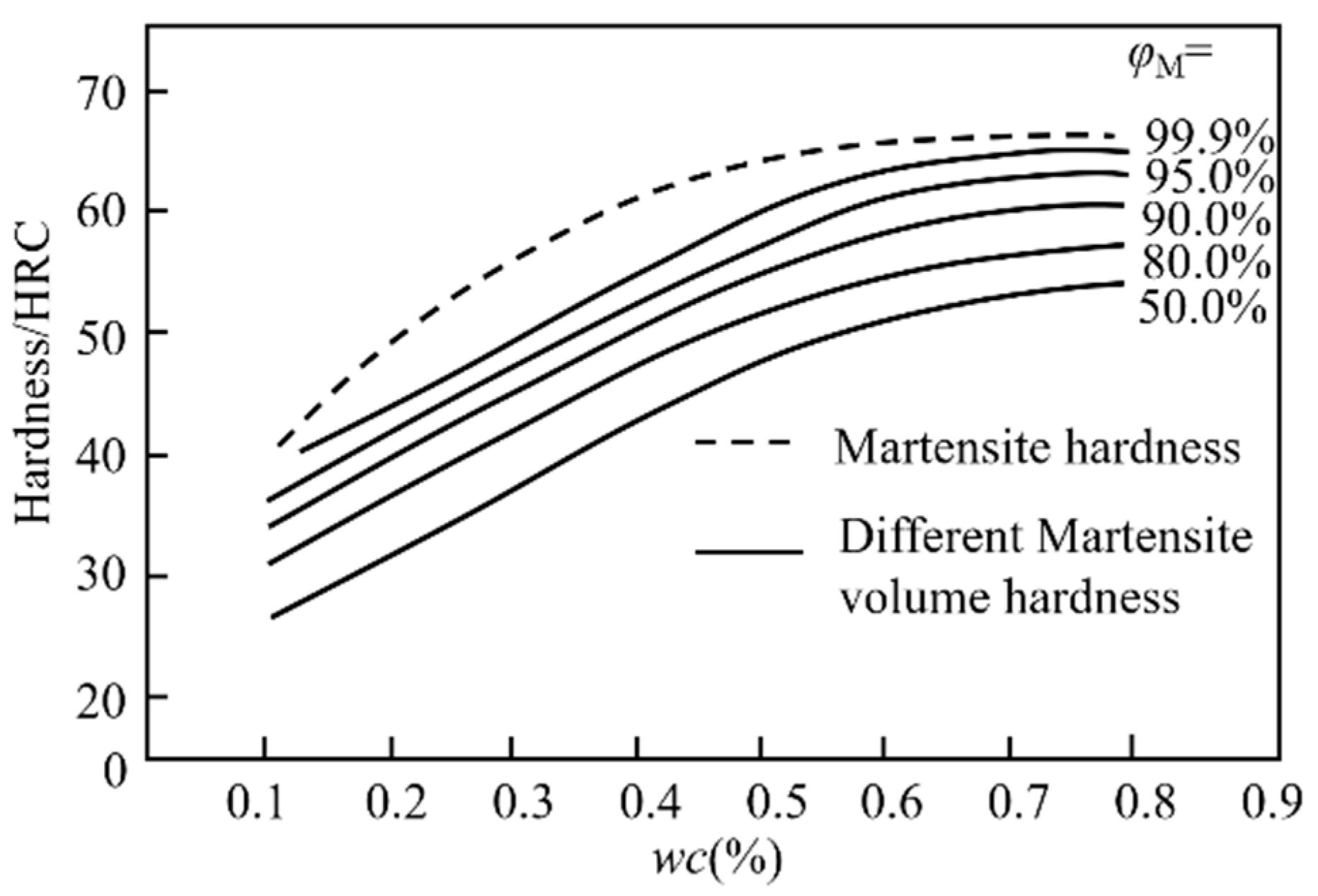


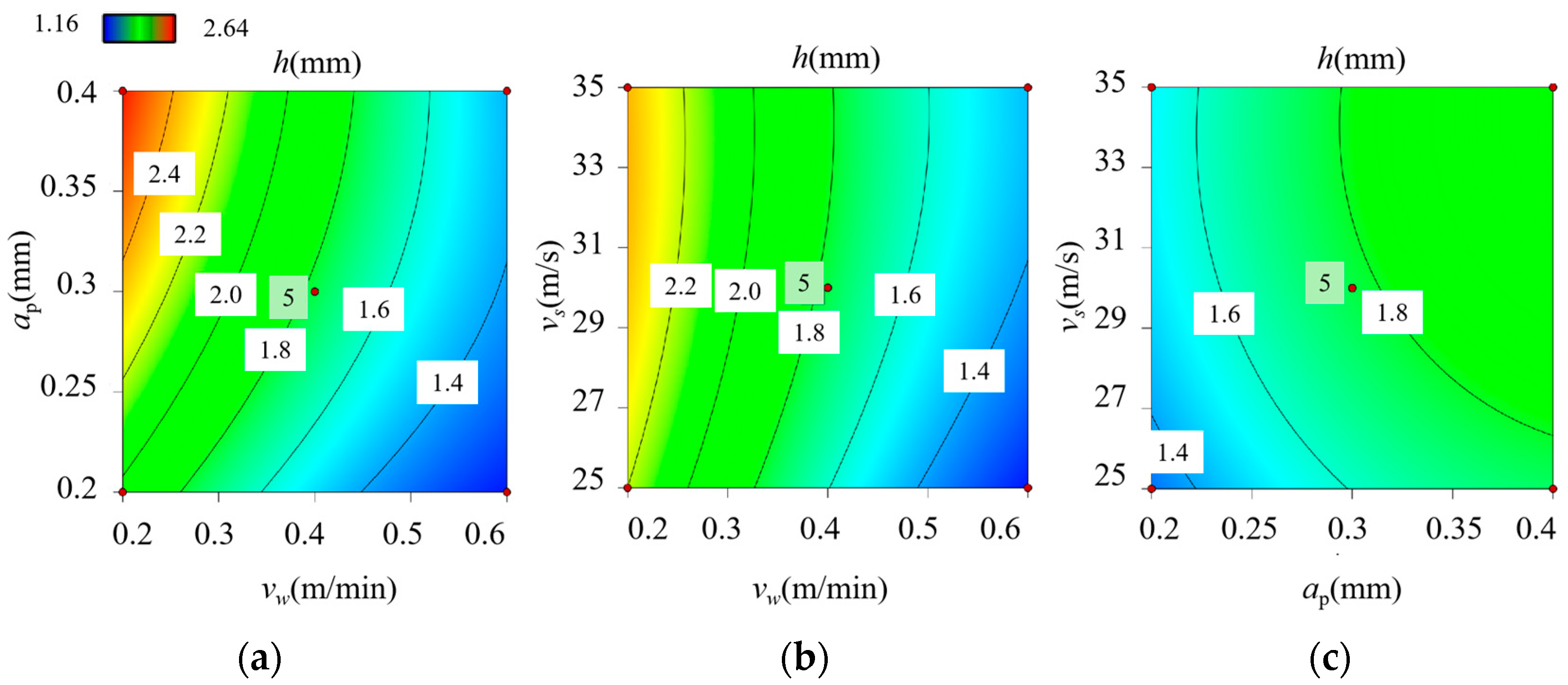

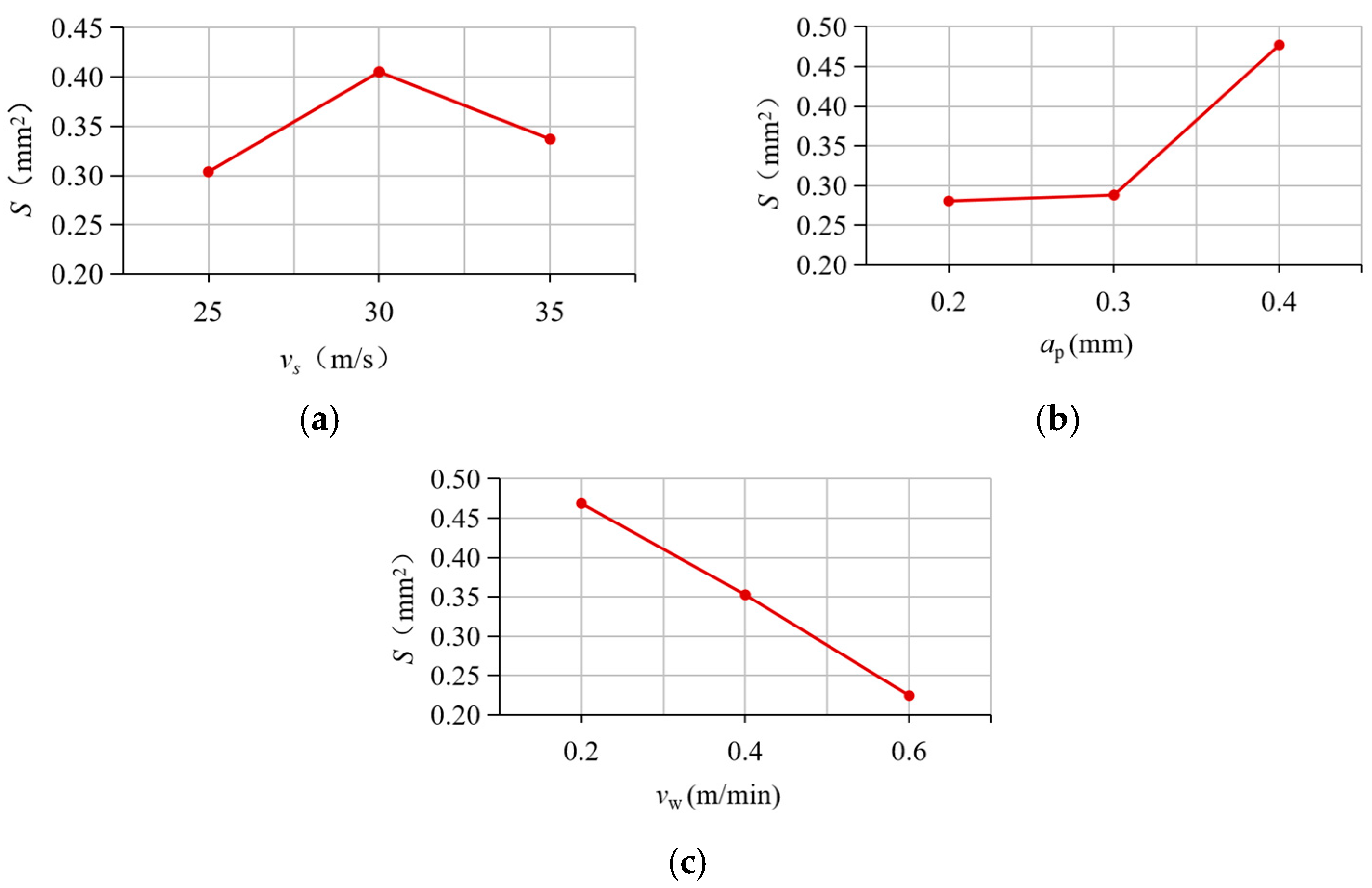


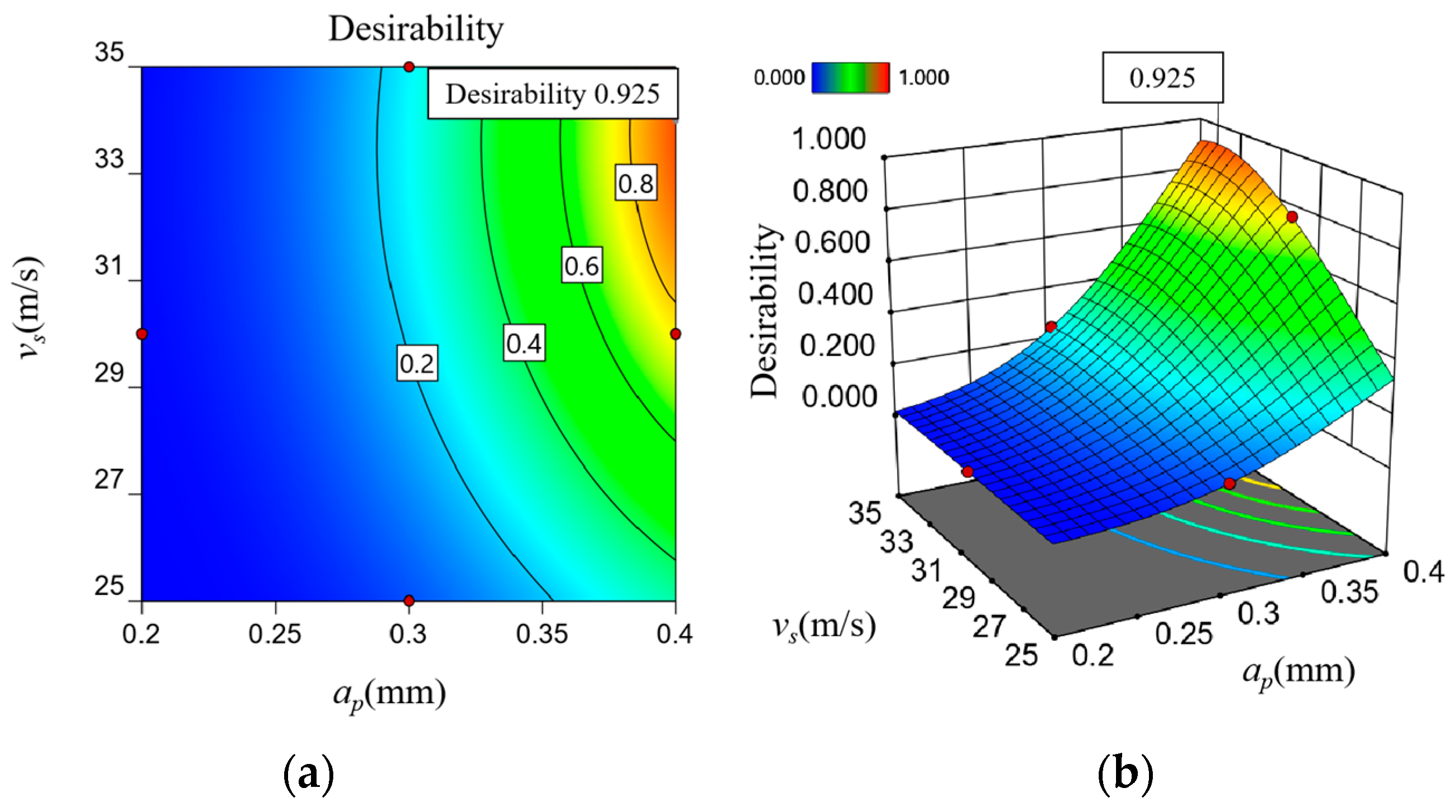
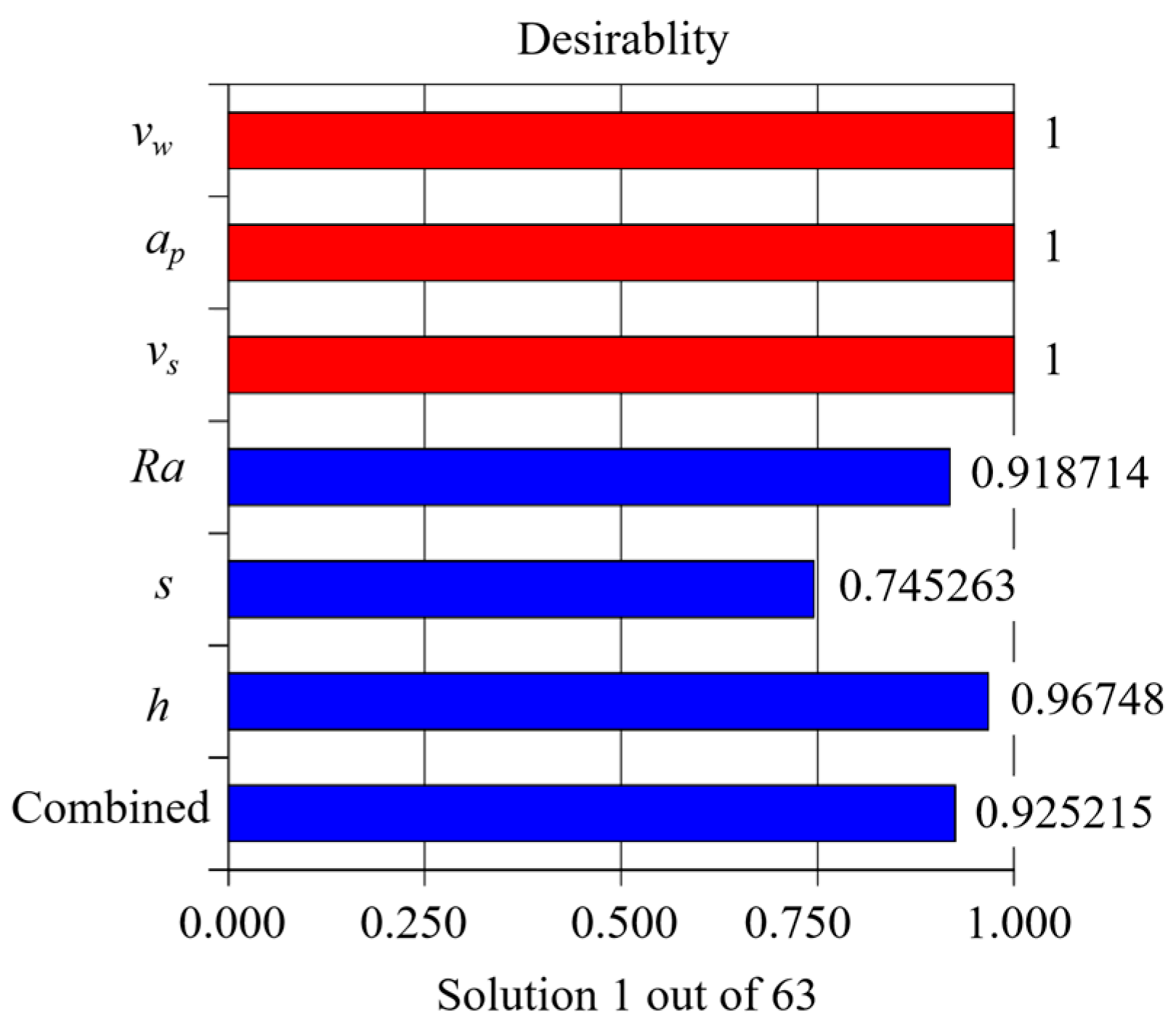


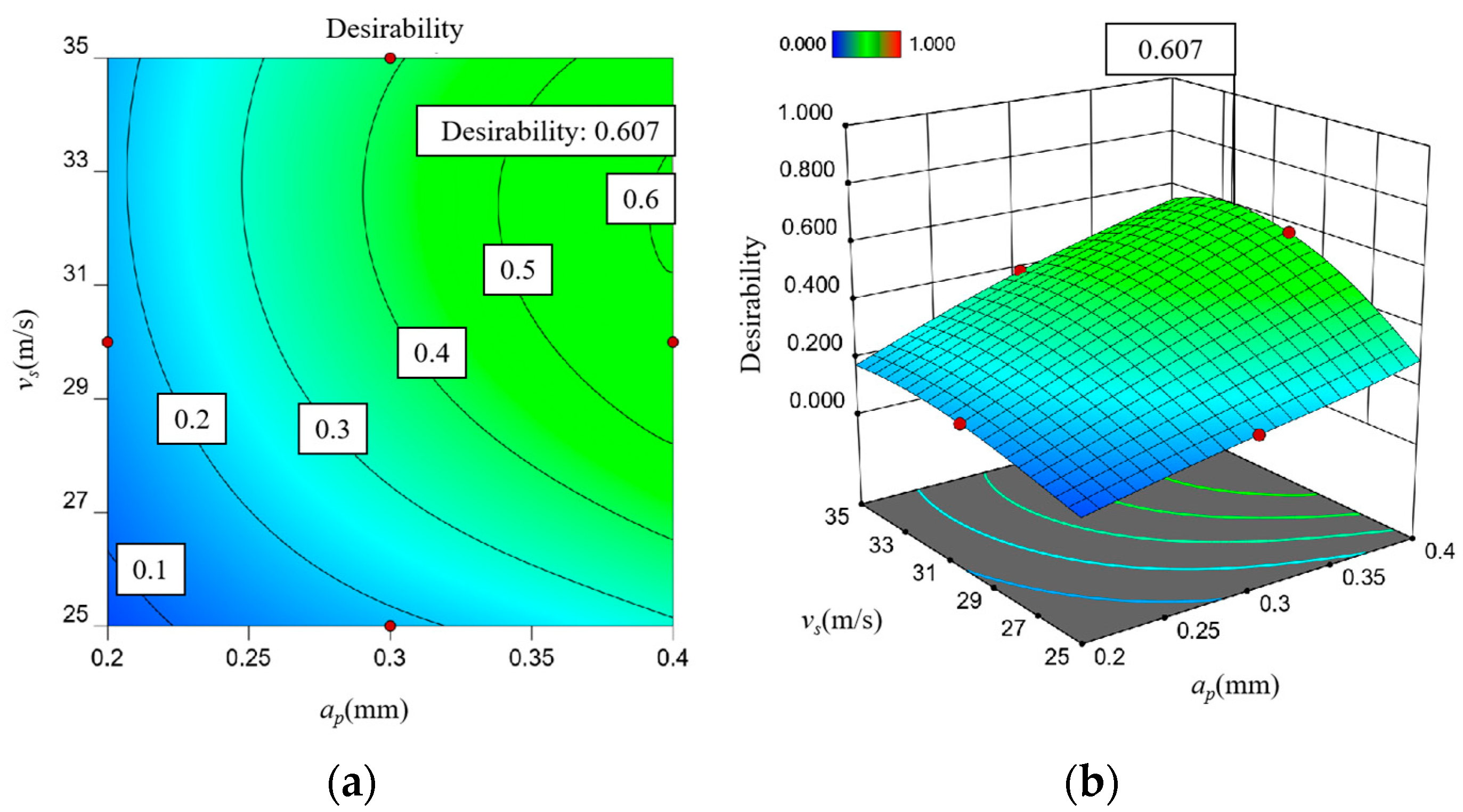
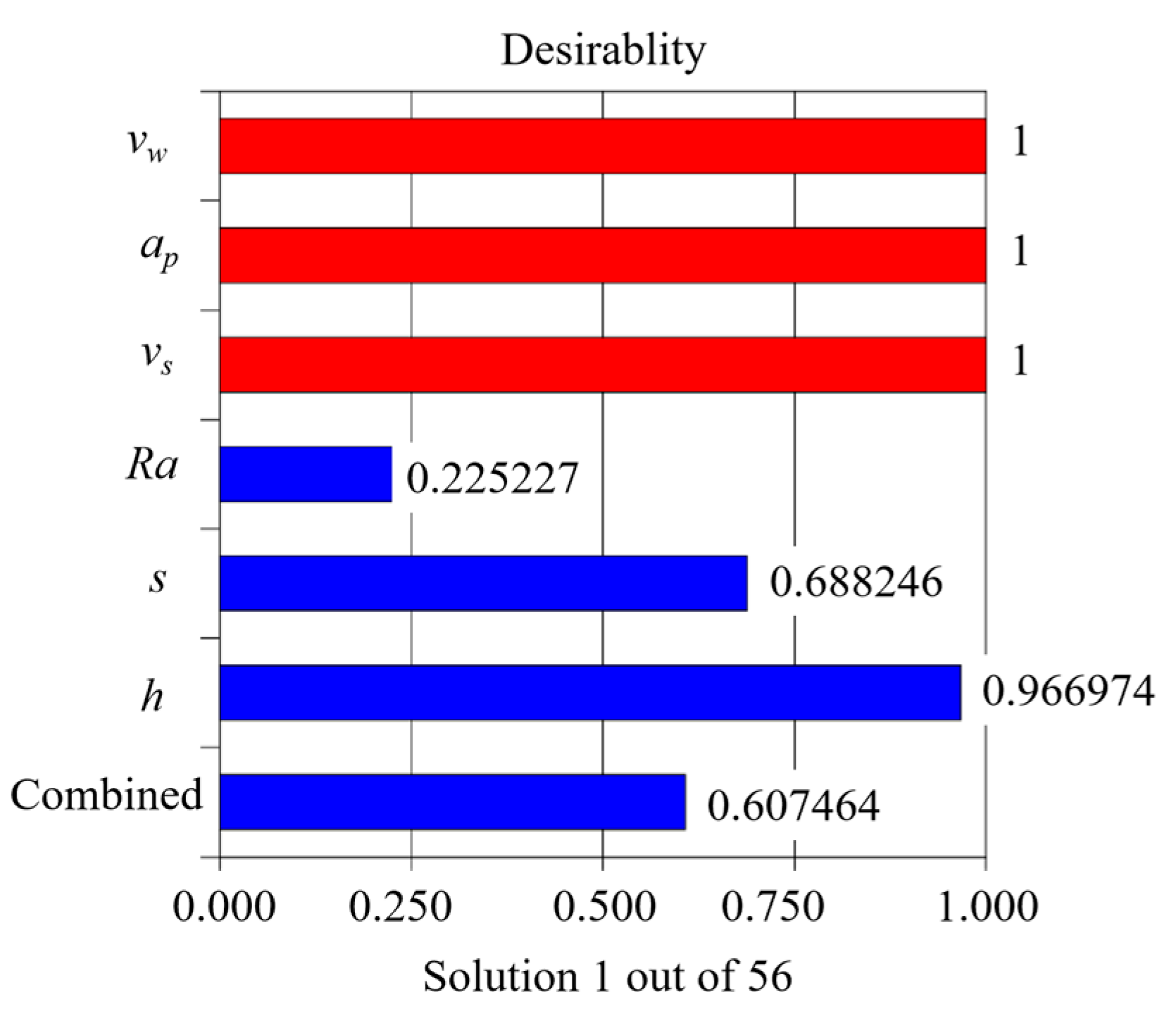
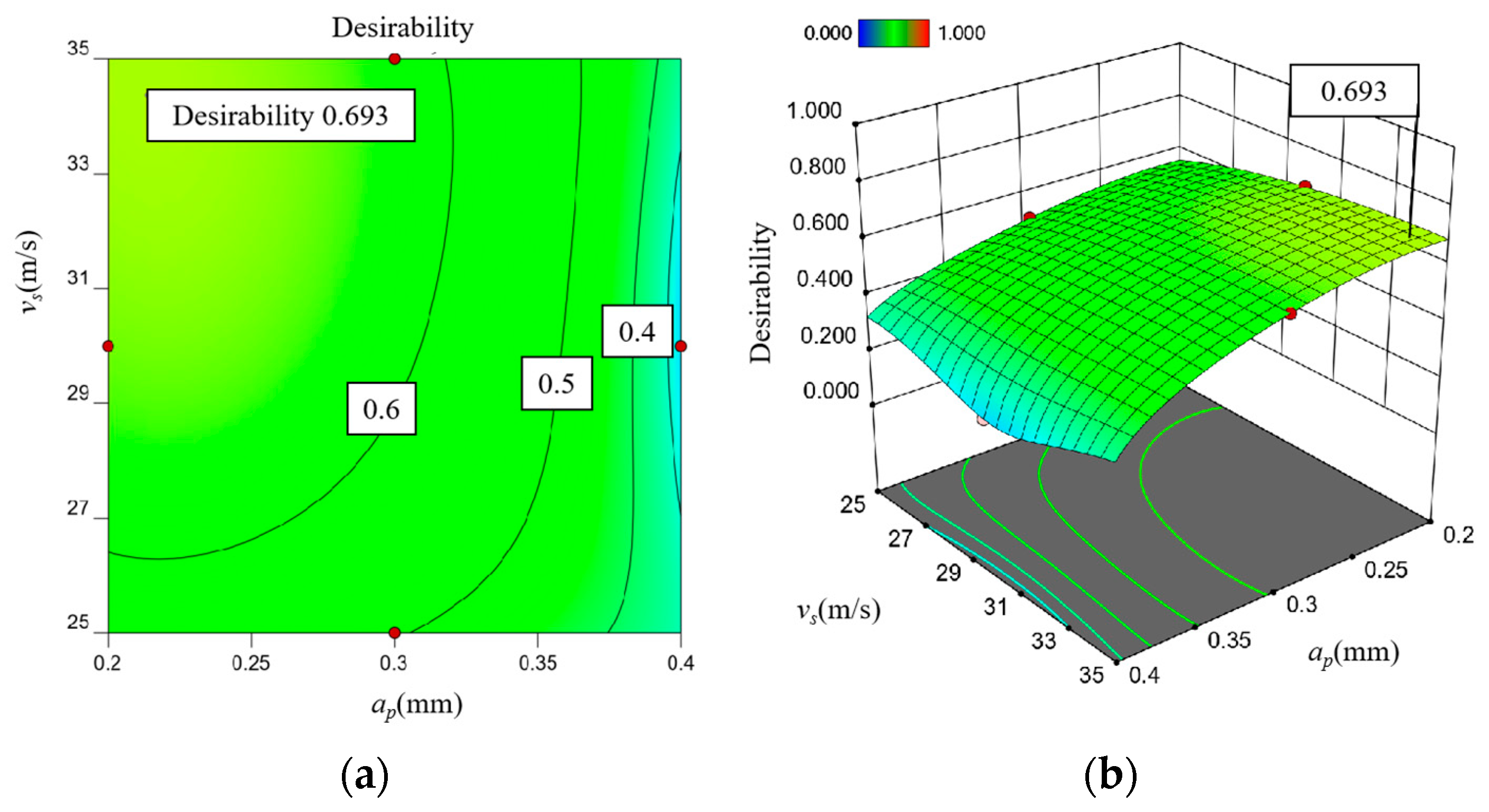

| Dressing Steps | Wheel Speed (m/s) | Dressing Depth (mm) | Dressing Feed Speed (mm/s) | Dressing Times |
|---|---|---|---|---|
| Preliminary | 25 | 0.02 | 1.5 | 2 |
| Truing | 25 | 0.01 | 1.5 | 2 |
| Composition | wt.% | Composition | wt.% |
|---|---|---|---|
| Cr | 0.90–1.20 | Mn | 0.50–0.80 |
| C | 0.38–0.45 | Cu/Ni | ≤0.30 |
| Mo | 0.15–0.25 | P | ≤0.035 |
| S | ≤0.035 | Si | 0.17–0.37 |
| Tensile Strength σb (MPa) | Yield Strength σs (MPa) | Hardness (HB) | Elongation δ (%) | Reduction of Area ψ (%) |
|---|---|---|---|---|
| ≥1080 | ≥930 | ≤217 | ≥12 | ≥45 |
| Grinding Parameter | Unit | Factor Coding | Parameter Setting | ||
|---|---|---|---|---|---|
| −1 | 0 | 1 | |||
| The workpiece feed rate vw | m/min | X1 | 0.2 | 0.4 | 0.6 |
| Grinding depth ap | mm | X2 | 0.2 | 0.3 | 0.4 |
| Grinding wheel speed vs | m/s | X3 | 25 | 30 | 35 |
| Grinding mode | One way, forward grinding, full width grinding | ||||
| No. | vw (m/min) | ap (mm) | vs (m/s) | Ra (μm) | h (mm) | S (mm2) |
|---|---|---|---|---|---|---|
| 1 | 0.2 | 0.2 | 30 | 1.28 | 1.98 | 0.3661 |
| 2 | 0.6 | 0.2 | 30 | 1.85 | 1.16 | 0.2510 |
| 3 | 0.2 | 0.4 | 30 | 1.81 | 2.64 | 0.7112 |
| 4 | 0.6 | 0.4 | 30 | 2.54 | 1.41 | 0.2923 |
| 5 | 0.2 | 0.3 | 25 | 2.26 | 2.21 | 0.3957 |
| 6 | 0.6 | 0.3 | 25 | 2.3 | 1.27 | 0.1470 |
| 7 | 0.2 | 0.3 | 35 | 2.03 | 2.31 | 0.4016 |
| 8 | 0.6 | 0.3 | 35 | 2.30 | 1.43 | 0.1900 |
| 9 | 0.4 | 0.2 | 25 | 1.87 | 1.30 | 0.2408 |
| 10 | 0.4 | 0.4 | 25 | 2.39 | 1.69 | 0.4316 |
| 11 | 0.4 | 0.2 | 35 | 1.56 | 1.57 | 0.2643 |
| 12 | 0.4 | 0.4 | 35 | 2.29 | 1.99 | 0.4738 |
| 13 | 0.4 | 0.3 | 30 | 1.91 | 1.73 | 0.3434 |
| 14 | 0.4 | 0.3 | 30 | 2.06 | 1.75 | 0.3163 |
| 15 | 0.4 | 0.3 | 30 | 2.10 | 1.86 | 0.3097 |
| 16 | 0.4 | 0.3 | 30 | 1.95 | 1.81 | 0.3188 |
| 17 | 0.4 | 0.3 | 30 | 1.85 | 1.71 | 0.3388 |
| No. | Optimization Principle | Surface Integrity Index | Surface Quality Requirement | Applicable Component |
|---|---|---|---|---|
| Optimization criterion 1 | Maximizing the hardened layer depth as the primary optimization factor. | Surface hardness and effective hardened layer depth, as well as favorable stress distribution, can effectively improve surface wear resistance. | Subject to severe alternating and shock loads, good wear resistance and fatigue strength are required [29,30]. | Crankshafts and crankshaft connecting rods of automobile engines, large bearing rings for high-speed railways and wind power generation, etc. |
| Optimization criterion 2 | Surface roughness as the primary optimization factor, and depth of the effective hardened layer as the secondary factor. | A smaller surface roughness and surface microhardness lead to a greater corrosion resistance. | The harsh working environment is easy to cause the corrosion and failure of components, resulting in higher requirements for the surface quality and surface corrosion resistance of components [31,32]. | Marine equipment components, drilling joints, pump components, salvage equipment, and oil and gas drilling tools. |
| Optimization criterion 3 | Effective hardened layer depth as the primary optimization factor, and surface roughness as the secondary factor. | The increased depth of the effective hardened layer and the presence of residual compressive stress in the surface layer of the specimen improve the rolling contact fatigue properties of the material. | In the case of heavy load for a long time, the more common failure form is fatigue damage, which requires the spindle bearing ring raceway to have a certain depth of hardened layer, thereby enhancing the fatigue strength [33,34]. | Heavy duty bearings, large wind turbine spindle bearings. |
| Optimization criterion 4 | The depth of the effective hardened layer is the main optimization factor, followed by surface roughness and edge quality. | Ensure the depth of the effective hardened layer while controlling surface roughness and edge quality. | Ensure machining accuracy; achieve a certain surface hardness to avoid surface quenching cracks [35,36]. | Large-size, high-strength bolts for diesel engines, wind power generation equipment, and important components for ring cranes, etc. |
| Name | Goal | Lower Limit | Upper Limit | Lower Weight | Upper Weight | Importance | |
|---|---|---|---|---|---|---|---|
| vw (m/min) | Is in range | 0.2 | 0.6 | 1 | 1 | 3 | |
| ap (mm) | Is in range | 0.2 | 0.4 | 1 | 1 | 3 | |
| vs (m/s) | Is in range | 25 | 35 | 1 | 1 | 3 | |
| Optimization criterion 1 | Ra (μm) | Minimize | 1.28 | 2.54 | 0.1 | 0.1 | + |
| S (mm2) | Is target = 0.1470 | 0.1470 | 0.7112 | 0.1 | 0.1 | + | |
| h (mm) | Maximize | 1.16 | 2.64 | 10 | 10 | +++++ | |
| Optimization criterion 2 | Ra (μm) | Minimize | 1.28 | 2.54 | 5 | 5 | +++++ |
| S (mm2) | Is target = 0.1470 | 0.1470 | 0.7112 | 0.1 | 0.1 | + | |
| h (mm) | Is target = 2.64 | 1.16 | 2.64 | 1 | 1 | ++ | |
| Optimization criterion 3 | Ra (μm) | Minimize | 1.28 | 2.54 | 2 | 2 | ++ |
| S (mm2) | Is target = 0.1470 | 0.1470 | 0.7112 | 0.1 | 0.1 | + | |
| h (mm) | Maximize | 1.16 | 2.64 | 5 | 5 | ++++ | |
| Optimization criterion 4 | Ra (μm) | Minimize | 1.28 | 2.54 | 1 | 1 | +++ |
| S (mm2) | Minimize | 0.1470 | 0.7112 | 1 | 1 | +++ | |
| h (mm) | Maximize | 1.16 | 2.64 | 1 | 1 | ++++ | |
| NO. | vw (m/min) | ap (mm) | vs (m/s) | Ra (μm) | S (mm2) | h (mm) | Desirability |
|---|---|---|---|---|---|---|---|
| Optimization criterion 1 | 0.200 | 0.400 | 33.995 | 2.000 | 0.681 | 2.635 | 0.925 |
| Optimization criterion 2 | 0.200 | 0.200 | 32.322 | 1.355 | 0.345 | 1.988 | 0.711 |
| Optimization criterion 3 | 0.200 | 0.400 | 32.368 | 1.942 | 0.698 | 2.630 | 0.607 |
| Optimization criterion 4 | 0.200 | 0.214 | 34.375 | 1.473 | 0.325 | 2.049 | 0.693 |
| NO. | vw (m/min) | ap (mm) | vs (m/s) | Ra (μm) | S (mm2) | h (mm) | |
|---|---|---|---|---|---|---|---|
| Optimization criterion 1 | 0.2 | 0.4 | 33.995 | Measured value | 2.56 | 0.6981 | 2.65 |
| Predicted value | 2.000 | 0.681 | 2.635 | ||||
| Relative error | |Ra′–Ra|/Ra | |S′–S|/S | |h′–h|/h | ||||
| 21.86% | 2.40% | 0.56% | |||||
| Optimization criterion 2 | 0.2 | 0.2 | 32.322 | Measured value | 1.51 | 0.3589 | 1.94 |
| Predicted value | 1.355 | 0.345 | 1.988 | ||||
| Relative error | |Ra′–Ra|/Ra | |S′–S|/S | |h′–h|/h | ||||
| 10.28% | 3.83% | 2.46% | |||||
| Optimization criterion 3 | 0.2 | 0.4 | 32.368 | Measured value | 2.37 | 0.6845 | 2.58 |
| Predicted value | 1.942 | 0.698 | 2.630 | ||||
| Relative error | |Ra′–Ra|/Ra | |S′–S|/S | |h′–h|/h | ||||
| 18.06% | 1.94% | 1.94% | |||||
| Optimization criterion 4 | 0.2 | 0.214 | 34.375 | Measured value | 1.90 | 0.3417 | 2.17 |
| Predicted value | 1.473 | 0.325 | 2.049 | ||||
| Relative error | |Ra′–Ra|/Ra | |S′–S|/S | |h′–h|/h | ||||
| 22.47% | 4.90% | 5.58% |
Disclaimer/Publisher’s Note: The statements, opinions and data contained in all publications are solely those of the individual author(s) and contributor(s) and not of MDPI and/or the editor(s). MDPI and/or the editor(s) disclaim responsibility for any injury to people or property resulting from any ideas, methods, instructions or products referred to in the content. |
© 2024 by the authors. Licensee MDPI, Basel, Switzerland. This article is an open access article distributed under the terms and conditions of the Creative Commons Attribution (CC BY) license (https://creativecommons.org/licenses/by/4.0/).
Share and Cite
Wang, C.; Wang, G.; Shen, C.; Dai, X. Multi-Objective Optimization of Surface Integrity in the Grind-Hardening Process. Coatings 2024, 14, 910. https://doi.org/10.3390/coatings14070910
Wang C, Wang G, Shen C, Dai X. Multi-Objective Optimization of Surface Integrity in the Grind-Hardening Process. Coatings. 2024; 14(7):910. https://doi.org/10.3390/coatings14070910
Chicago/Turabian StyleWang, Chunyan, Guicheng Wang, Chungen Shen, and Xinyu Dai. 2024. "Multi-Objective Optimization of Surface Integrity in the Grind-Hardening Process" Coatings 14, no. 7: 910. https://doi.org/10.3390/coatings14070910
APA StyleWang, C., Wang, G., Shen, C., & Dai, X. (2024). Multi-Objective Optimization of Surface Integrity in the Grind-Hardening Process. Coatings, 14(7), 910. https://doi.org/10.3390/coatings14070910





